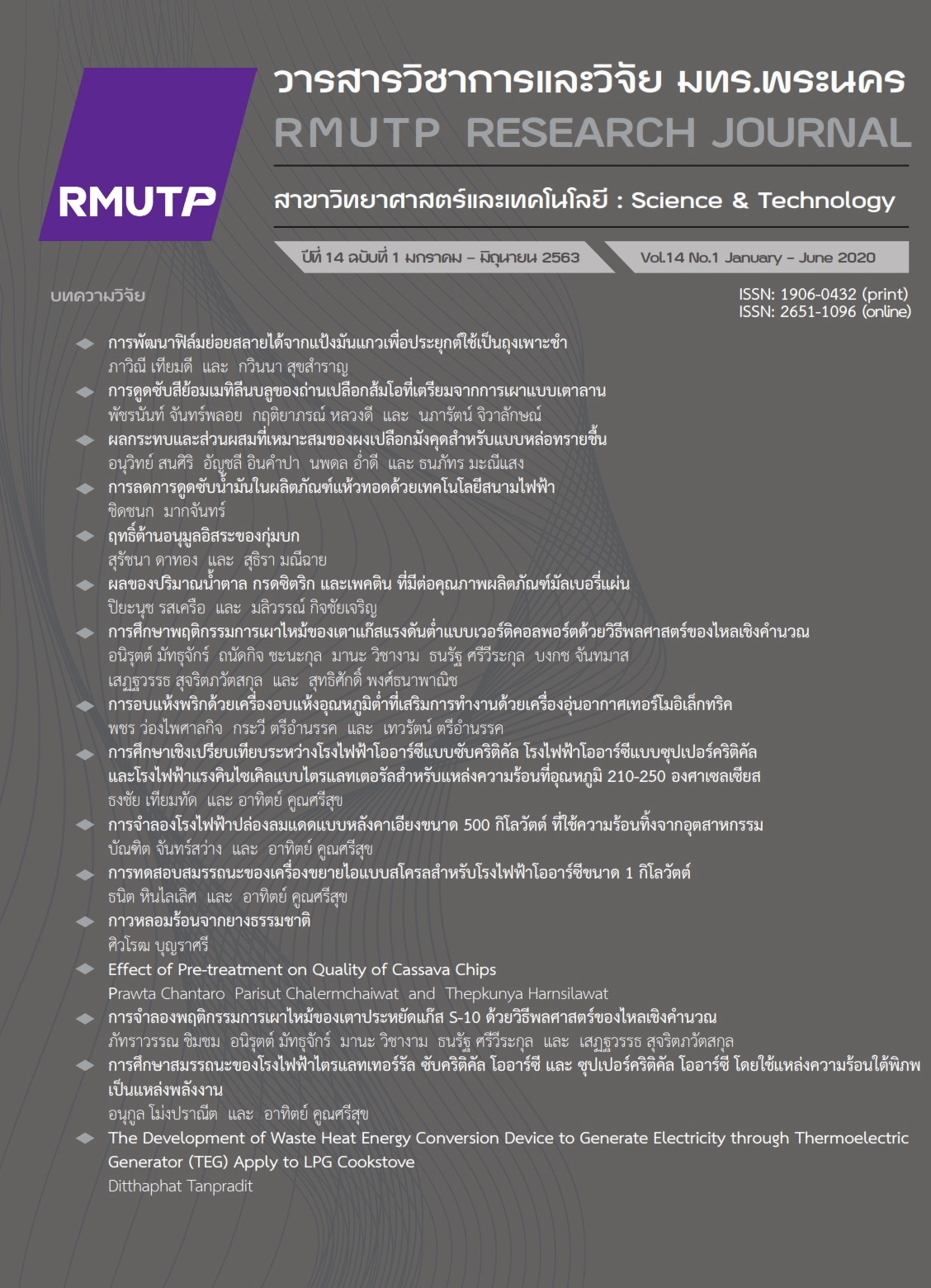Effects of Sugar, Citric acid and Pectin Content on Quality of Mulberry Fruit Leather Product
Main Article Content
Abstract
The objective of this study was to investigate the optimal formulation of mulberry fruit leather product when varying the weight ratio of mulberry fruit: water as 70:30, 60:40, 50:50, 40:60 and 30:70. Three factors were then determined by simplex centroid design; sugar (0-100% or 0-50 grams), citric acid (0-100% or 0-5 grams) and pectin (0-100% or 0-3 grams), which the sum of them equivalent to 100% while other ingredients remained constant. Analysis of the data was performed using ANOVA and Mixture Response Surface Models.The results indicated that the highest adhesiveness force and gumminess of mulberry fruit leather product were founded when the weight ratio of mulberry fruit to water was 70:30. The amount of sugar, acid and pectin had effects on water activity (Aw), texture profile and sensory score of overall liking of product. From contour plot, the predictive models were obtained by plotting the contour line of all sensory attributes with acceptable score greater than 5.5 and thus the optimization area was selected. After overlapping contour plots, an optimal formulation obtained was composed of 40-70% sugar, 0-5% citric acid and 30-55% pectin. The sensory score of overall liking of product using a 9-point hedonic scale was 6.3. The water activity (Aw), adhesiveness force, cohesiveness and gumminess of the prototype mulberry fruit leather product was 4.9, 945.11 g. sec., 0.85 N and 452.12 N., respectively.
Article Details
References
S.Ercisli and E.Orhan, “Chemical composition of white (Morus alba), red (Morus rubra) and black (Morus nigra) mulberry fruits,” Food Chemistry, vol. 103, no. 4, pp. 1380–1384, Jan. 2007.
S. Kaya and T. Kahyaoglu, “Thermodynamic properties and sorption equilibrium of pestil (grape leather),” Journal of Food Engineering, vol. 71, no. 2, pp. 200–207, Nov. 2005.
C. Raab and N. Oehler, “Making Dried Fruit Leather,” Fact Sheet 232, Oregon State University Extension Service, Tillamook, Ore, USA, May. 2000.
A.L. Moyls, “Drying of Apple Purees,” Journal of Food Science, vol. 46, no. 3, pp. 939–942, May 1981.
N. A. Quintero Ruiz, S. M. Demarchi, J. F. Massolo, L. M. Rodoni and S. A. Giner, “Evaluation of quality during storage of apple leather,” LWT, vol. 47, no. 2, pp. 485–492, Jul. 2012.
R. Kumar, R. T. Patil and G. Mondal, “Development and evaluation of blended papaya leather,” Acta Horticulturae, vol. 851, pp. 565–570, Jan. 2010.
S. O. Babalola, O. A. Ashaye, A. O. Babalola and J. O. Aina. “Effect of cold temperature storage on quality attributes of pawpaw and guava leathers,” African Journal of Biotechnology, vol. 1, no. 2, pp. 61-63, Dec. 2002.
Y. B. C. Man, I. Jaswir, S. Yusof, J. Selamat and H. Sugisawa, “Effect of different dryers and drying conditions on acceptability and physicochemical characteristics of durian leather,” Journal of Food Processing and Preservation, vol. 21, no. 5, pp. 425–441, Nov. 1997.
S.Saencom, N.Chiewchan and S. Devahastin, “Production of dried ivy gourd sheet as a health snack,” Food and Bioproducts Processing, vol. 89, no. 4, pp. 414–421, Oct. 2011.
S. Hematurin, P. Songsri, B. Suriharn and K. Lertrat, “The development of natural mao leather product,” Khon Kaen Agriculture Journal, vol. 42, Suppl. 4, pp. 112-117, 2014.
L. Diamante, S. Li, Q. Xu and J. Busch, “Effects of Apple Juice Concentrate, Blackcurrant Concentrate and Pectin Levels on Selected Qualities of Apple-Blackcurrant Fruit Leather,” Foods, vol. 2, no. 3, pp. 430–443, Sep. 2013.
C. Phimpharian, A. Jangchud, K. Jangchud, N. Therdthai, W. Prinyawiwatkul and H. K. No, “Physicochemical characteristics and sensory optimisation of pineapple leather snack as affected by glucose syrup and pectin concentrations: Machine-formed pineapple leathers,” International Journal of Food Science & Technology, vol. 46, no. 5, pp. 972–981, May 2011.
H. Singh Gujral and S. Singh Brar, “Effect of Hydrocolloids on the Dehydration Kinetics, Color, and Texture of Mango Leather,” International Journal of Food Properties, vol. 6, no. 2, pp. 269–279, Jan. 2003.
M. M. I. Chowdhury, B. K. Bala, and M. A. Haque, “Mathematical modeling of thin-layer drying of jackfruit leather,” Journal of Food Processing and Preservation, vol. 35, no. 6, pp. 797–805, Dec. 2011.


